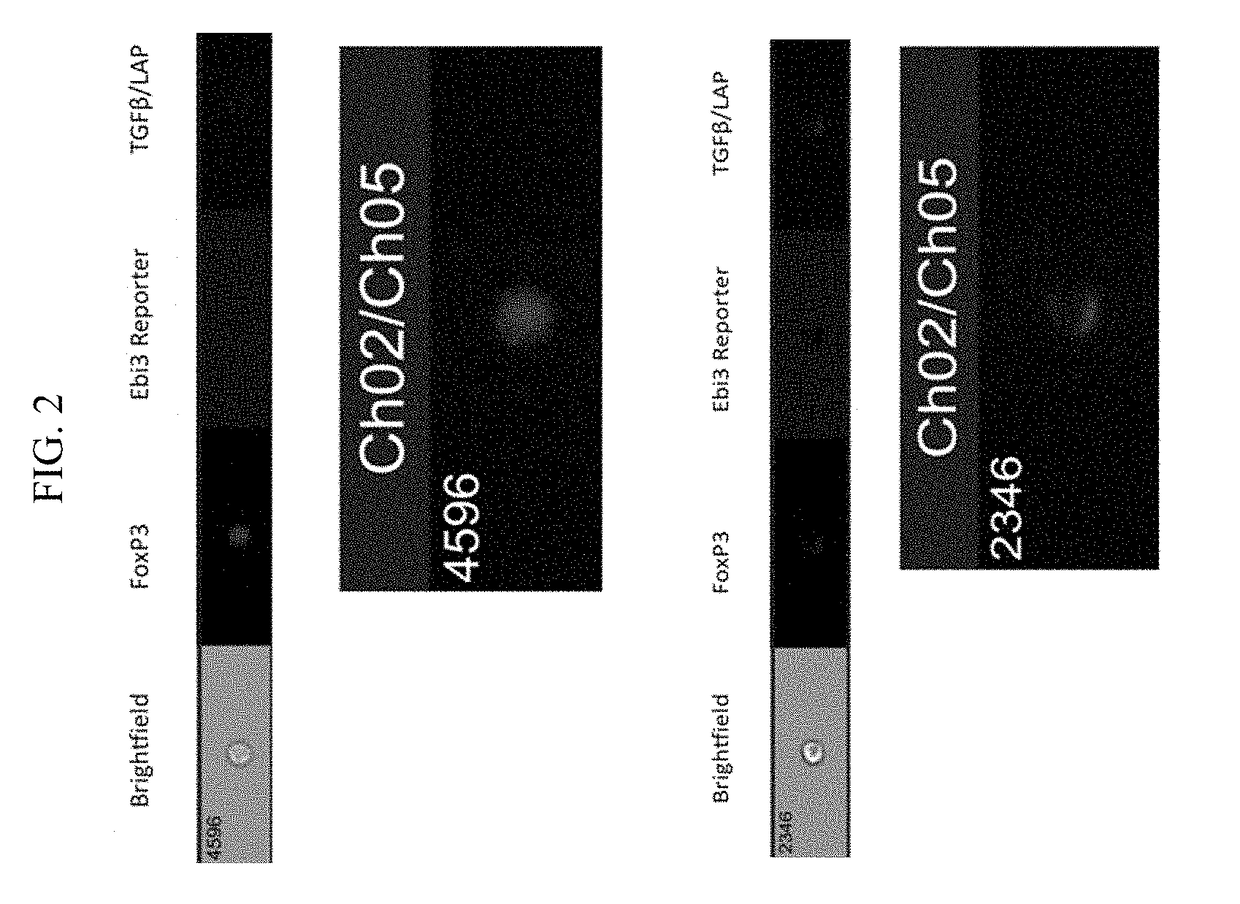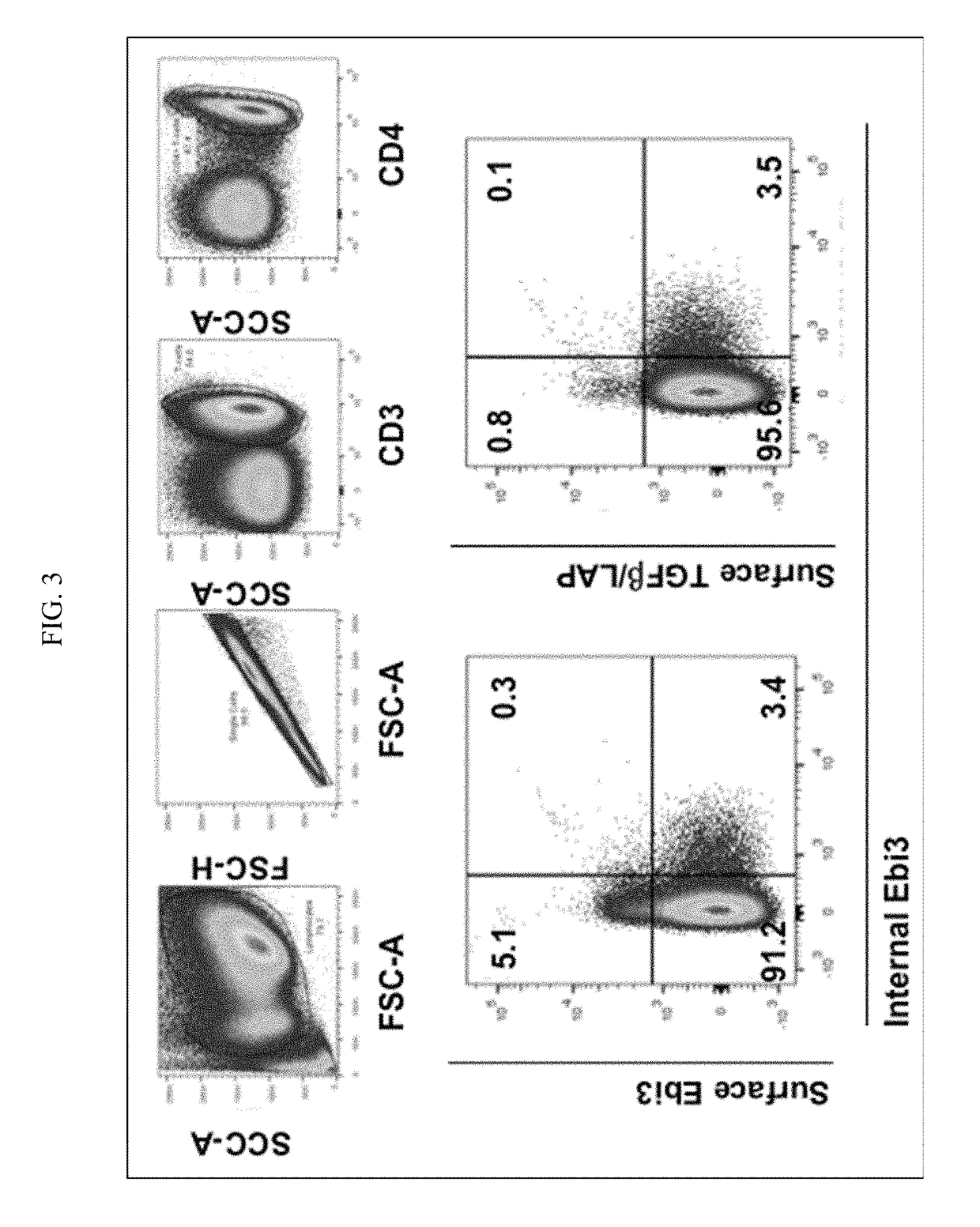T cell-bound cytokine assay for antigen-specific tolerance
a cytokine and antigen-specific technology, applied in the field of t cell-bound cytokine assay for antigen-specific tolerance, can solve the problems of few assays, few assays, and little success in developing in vitro non-animal assays
- Summary
- Abstract
- Description
- Claims
- Application Information
AI Technical Summary
Benefits of technology
Problems solved by technology
Method used
Image
Examples
example 1
en-Specific Response Following Donor-Specific Transfusion (DST) and Co-Stimulatory Blockade Treatment in CBA-Tolerized Mice
[0050]To initially validate the T-CBC assay, we induced tolerance in C57BL / 6 (“B6”) mice to CBA antigens using a donor-specific transfusion (DST) plus anti-CD154 (CD154 is also known as CD40 Ligand) tolerization method. The term “CBA antigens” refers to a lysate of spleen cells obtained from a mouse of the CBA strain and prepared by sonication. Following sonication and centrifugation at 10,000×g, the liquid supernatant is used as the source of CBA antigens. CD154 (aka CD40 Ligand) is a membrane glycoprotein and differentiation antigen transiently expressed on the surface of activated T cells. Through the binding of CD154 to CD40 on antigen presenting cells (APC) including B cells, monocytes / macrophages, and dendritic cells, it serves a crucial function in T cell-APC cognate interaction. CD154-interaction with CD40 transduces signals for T-dependent B cell activa...
example 2
Quantifying Treg Cells Specific for Self-Antigens or Donor Alloantigens
[0055]Materials and Methods:
[0056]Single cell suspensions of spleen, lymph node cells or peripheral blood mononuclear cells were cultured overnight in DMEM+10% FBS in the presence of a specific test antigen or crude cell lysate. When measuring alloantigen-specific induction of tolerance, the antigen preparation was a supernatant obtained from a sonicate of 10×106 donor spleen, lymph node cells or peripheral blood mononuclear cells, centrifuged at 10,000×g for 14 minutes at 4° C. with phenylmethylsulfonyl fluoride (PMSF) and protease inhibitor iodoacetamide (IAA) at a concentration of 4×107 cell equivalents per mL. To measure allospecific Treg, no intact donor cells are used. Both nanovesicles and soluble protein are present in these crude antigen preps. See e.g., Bracamonte-Baran and Burlingham, Biomed. J. 2015, 38(1):39-51.
[0057]When detecting self-antigen-specific Treg cells, the antigen preparations can contai...
example 3
face Staining
[0068]Single cell suspensions were prepared from spleen, lymph nodes, or other tissues of interest. Staining for live and dead cells was performed prior to surface staining with IL-35 antibody. LIVE / DEAD® fixable dead cell stain Aqua (Invitrogen) was used at a dilution of 1:700 in phosphate buffered saline. Alternatively, scatter gates can be used to exclude apoptotic cells and doublets. After washing off the live / dead stain, we prepared a staining cocktail for surface markers for staining different lymphocyte populations based on the experimental needs. A Foxp3 reporter mouse was used for Treg analysis. A staining cocktail composition for detecting surface expression of IL-35 on Treg / Teff cells is listed below:
[0069]NMS (10%) of staining buffer (FACS) volume
[0070]CD4 (at 1:500 dilution)
[0071]CD25 (at 1:500 dilution)
[0072]CD45RB (at 1:500 dilution)
[0073]Ebi3 Biotin-linked antibody (V1.4F5.29 clone described by Collison et al, Nature Immunol., 2010). The stock concentrat...
PUM
| Property | Measurement | Unit |
|---|---|---|
| size | aaaaa | aaaaa |
| concentration | aaaaa | aaaaa |
| concentration | aaaaa | aaaaa |
Abstract
Description
Claims
Application Information
 Login to View More
Login to View More - R&D
- Intellectual Property
- Life Sciences
- Materials
- Tech Scout
- Unparalleled Data Quality
- Higher Quality Content
- 60% Fewer Hallucinations
Browse by: Latest US Patents, China's latest patents, Technical Efficacy Thesaurus, Application Domain, Technology Topic, Popular Technical Reports.
© 2025 PatSnap. All rights reserved.Legal|Privacy policy|Modern Slavery Act Transparency Statement|Sitemap|About US| Contact US: help@patsnap.com



